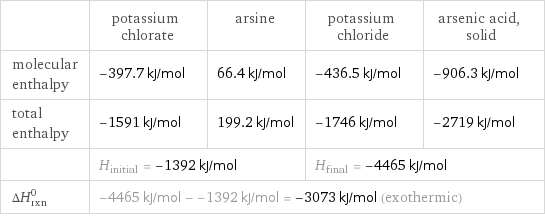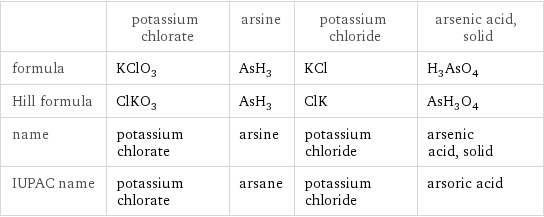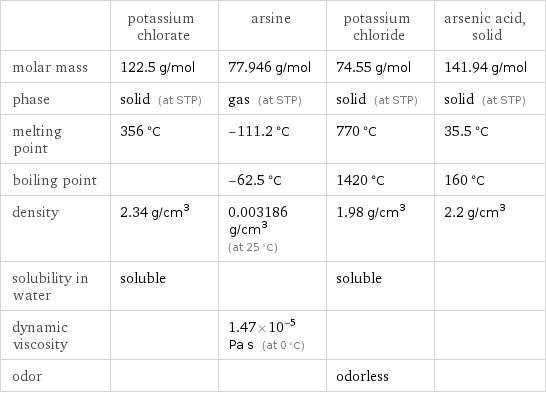Input interpretation

KClO_3 potassium chlorate + AsH_3 arsine ⟶ KCl potassium chloride + H_3AsO_4 arsenic acid, solid
Balanced equation

Balance the chemical equation algebraically: KClO_3 + AsH_3 ⟶ KCl + H_3AsO_4 Add stoichiometric coefficients, c_i, to the reactants and products: c_1 KClO_3 + c_2 AsH_3 ⟶ c_3 KCl + c_4 H_3AsO_4 Set the number of atoms in the reactants equal to the number of atoms in the products for Cl, K, O, As and H: Cl: | c_1 = c_3 K: | c_1 = c_3 O: | 3 c_1 = 4 c_4 As: | c_2 = c_4 H: | 3 c_2 = 3 c_4 Since the coefficients are relative quantities and underdetermined, choose a coefficient to set arbitrarily. To keep the coefficients small, the arbitrary value is ordinarily one. For instance, set c_2 = 1 and solve the system of equations for the remaining coefficients: c_1 = 4/3 c_2 = 1 c_3 = 4/3 c_4 = 1 Multiply by the least common denominator, 3, to eliminate fractional coefficients: c_1 = 4 c_2 = 3 c_3 = 4 c_4 = 3 Substitute the coefficients into the chemical reaction to obtain the balanced equation: Answer: | | 4 KClO_3 + 3 AsH_3 ⟶ 4 KCl + 3 H_3AsO_4
Structures

+ ⟶ +
Names

potassium chlorate + arsine ⟶ potassium chloride + arsenic acid, solid
Reaction thermodynamics
Enthalpy

| potassium chlorate | arsine | potassium chloride | arsenic acid, solid molecular enthalpy | -397.7 kJ/mol | 66.4 kJ/mol | -436.5 kJ/mol | -906.3 kJ/mol total enthalpy | -1591 kJ/mol | 199.2 kJ/mol | -1746 kJ/mol | -2719 kJ/mol | H_initial = -1392 kJ/mol | | H_final = -4465 kJ/mol | ΔH_rxn^0 | -4465 kJ/mol - -1392 kJ/mol = -3073 kJ/mol (exothermic) | | |
Equilibrium constant
![Construct the equilibrium constant, K, expression for: KClO_3 + AsH_3 ⟶ KCl + H_3AsO_4 Plan: • Balance the chemical equation. • Determine the stoichiometric numbers. • Assemble the activity expression for each chemical species. • Use the activity expressions to build the equilibrium constant expression. Write the balanced chemical equation: 4 KClO_3 + 3 AsH_3 ⟶ 4 KCl + 3 H_3AsO_4 Assign stoichiometric numbers, ν_i, using the stoichiometric coefficients, c_i, from the balanced chemical equation in the following manner: ν_i = -c_i for reactants and ν_i = c_i for products: chemical species | c_i | ν_i KClO_3 | 4 | -4 AsH_3 | 3 | -3 KCl | 4 | 4 H_3AsO_4 | 3 | 3 Assemble the activity expressions accounting for the state of matter and ν_i: chemical species | c_i | ν_i | activity expression KClO_3 | 4 | -4 | ([KClO3])^(-4) AsH_3 | 3 | -3 | ([AsH3])^(-3) KCl | 4 | 4 | ([KCl])^4 H_3AsO_4 | 3 | 3 | ([H3AsO4])^3 The equilibrium constant symbol in the concentration basis is: K_c Mulitply the activity expressions to arrive at the K_c expression: Answer: | | K_c = ([KClO3])^(-4) ([AsH3])^(-3) ([KCl])^4 ([H3AsO4])^3 = (([KCl])^4 ([H3AsO4])^3)/(([KClO3])^4 ([AsH3])^3)](../image_source/aef5f854fa50e7b23a4d1b5aadba1cf1.png)
Construct the equilibrium constant, K, expression for: KClO_3 + AsH_3 ⟶ KCl + H_3AsO_4 Plan: • Balance the chemical equation. • Determine the stoichiometric numbers. • Assemble the activity expression for each chemical species. • Use the activity expressions to build the equilibrium constant expression. Write the balanced chemical equation: 4 KClO_3 + 3 AsH_3 ⟶ 4 KCl + 3 H_3AsO_4 Assign stoichiometric numbers, ν_i, using the stoichiometric coefficients, c_i, from the balanced chemical equation in the following manner: ν_i = -c_i for reactants and ν_i = c_i for products: chemical species | c_i | ν_i KClO_3 | 4 | -4 AsH_3 | 3 | -3 KCl | 4 | 4 H_3AsO_4 | 3 | 3 Assemble the activity expressions accounting for the state of matter and ν_i: chemical species | c_i | ν_i | activity expression KClO_3 | 4 | -4 | ([KClO3])^(-4) AsH_3 | 3 | -3 | ([AsH3])^(-3) KCl | 4 | 4 | ([KCl])^4 H_3AsO_4 | 3 | 3 | ([H3AsO4])^3 The equilibrium constant symbol in the concentration basis is: K_c Mulitply the activity expressions to arrive at the K_c expression: Answer: | | K_c = ([KClO3])^(-4) ([AsH3])^(-3) ([KCl])^4 ([H3AsO4])^3 = (([KCl])^4 ([H3AsO4])^3)/(([KClO3])^4 ([AsH3])^3)
Rate of reaction
![Construct the rate of reaction expression for: KClO_3 + AsH_3 ⟶ KCl + H_3AsO_4 Plan: • Balance the chemical equation. • Determine the stoichiometric numbers. • Assemble the rate term for each chemical species. • Write the rate of reaction expression. Write the balanced chemical equation: 4 KClO_3 + 3 AsH_3 ⟶ 4 KCl + 3 H_3AsO_4 Assign stoichiometric numbers, ν_i, using the stoichiometric coefficients, c_i, from the balanced chemical equation in the following manner: ν_i = -c_i for reactants and ν_i = c_i for products: chemical species | c_i | ν_i KClO_3 | 4 | -4 AsH_3 | 3 | -3 KCl | 4 | 4 H_3AsO_4 | 3 | 3 The rate term for each chemical species, B_i, is 1/ν_i(Δ[B_i])/(Δt) where [B_i] is the amount concentration and t is time: chemical species | c_i | ν_i | rate term KClO_3 | 4 | -4 | -1/4 (Δ[KClO3])/(Δt) AsH_3 | 3 | -3 | -1/3 (Δ[AsH3])/(Δt) KCl | 4 | 4 | 1/4 (Δ[KCl])/(Δt) H_3AsO_4 | 3 | 3 | 1/3 (Δ[H3AsO4])/(Δt) (for infinitesimal rate of change, replace Δ with d) Set the rate terms equal to each other to arrive at the rate expression: Answer: | | rate = -1/4 (Δ[KClO3])/(Δt) = -1/3 (Δ[AsH3])/(Δt) = 1/4 (Δ[KCl])/(Δt) = 1/3 (Δ[H3AsO4])/(Δt) (assuming constant volume and no accumulation of intermediates or side products)](../image_source/8f3a4fea25e06428b35294a0b0fce4fd.png)
Construct the rate of reaction expression for: KClO_3 + AsH_3 ⟶ KCl + H_3AsO_4 Plan: • Balance the chemical equation. • Determine the stoichiometric numbers. • Assemble the rate term for each chemical species. • Write the rate of reaction expression. Write the balanced chemical equation: 4 KClO_3 + 3 AsH_3 ⟶ 4 KCl + 3 H_3AsO_4 Assign stoichiometric numbers, ν_i, using the stoichiometric coefficients, c_i, from the balanced chemical equation in the following manner: ν_i = -c_i for reactants and ν_i = c_i for products: chemical species | c_i | ν_i KClO_3 | 4 | -4 AsH_3 | 3 | -3 KCl | 4 | 4 H_3AsO_4 | 3 | 3 The rate term for each chemical species, B_i, is 1/ν_i(Δ[B_i])/(Δt) where [B_i] is the amount concentration and t is time: chemical species | c_i | ν_i | rate term KClO_3 | 4 | -4 | -1/4 (Δ[KClO3])/(Δt) AsH_3 | 3 | -3 | -1/3 (Δ[AsH3])/(Δt) KCl | 4 | 4 | 1/4 (Δ[KCl])/(Δt) H_3AsO_4 | 3 | 3 | 1/3 (Δ[H3AsO4])/(Δt) (for infinitesimal rate of change, replace Δ with d) Set the rate terms equal to each other to arrive at the rate expression: Answer: | | rate = -1/4 (Δ[KClO3])/(Δt) = -1/3 (Δ[AsH3])/(Δt) = 1/4 (Δ[KCl])/(Δt) = 1/3 (Δ[H3AsO4])/(Δt) (assuming constant volume and no accumulation of intermediates or side products)
Chemical names and formulas

| potassium chlorate | arsine | potassium chloride | arsenic acid, solid formula | KClO_3 | AsH_3 | KCl | H_3AsO_4 Hill formula | ClKO_3 | AsH_3 | ClK | AsH_3O_4 name | potassium chlorate | arsine | potassium chloride | arsenic acid, solid IUPAC name | potassium chlorate | arsane | potassium chloride | arsoric acid
Substance properties

| potassium chlorate | arsine | potassium chloride | arsenic acid, solid molar mass | 122.5 g/mol | 77.946 g/mol | 74.55 g/mol | 141.94 g/mol phase | solid (at STP) | gas (at STP) | solid (at STP) | solid (at STP) melting point | 356 °C | -111.2 °C | 770 °C | 35.5 °C boiling point | | -62.5 °C | 1420 °C | 160 °C density | 2.34 g/cm^3 | 0.003186 g/cm^3 (at 25 °C) | 1.98 g/cm^3 | 2.2 g/cm^3 solubility in water | soluble | | soluble | dynamic viscosity | | 1.47×10^-5 Pa s (at 0 °C) | | odor | | | odorless |
Units
